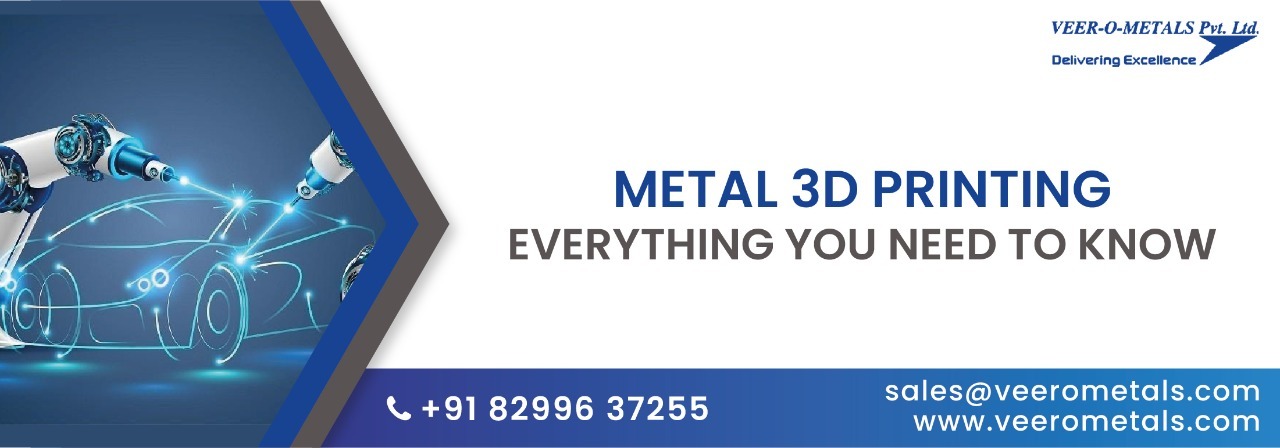METAL 3D PRINTING: EVERYTHING YOU NEED TO KNOW

The beauty of art lies not only in what all elements we add to it but also in, what elements we take out from it. This is what vests under the concept of Metal Additive Manufacturing, in common terms, referred to as Metal 3D Printing. It is an output of the biggest leap in technology that produces three-dimensional parts layer by layer from a metal material. In the modern era of technological innovations, there is no point in asking if it is possible to 3D print items from metal. The technology of Metal Additive Manufacturing makes it possible in the best way. Let us know how metal additive manufacturing works, the different types of metal 3D printing, its likely advantages and possible applications.
What is Metal 3D Printing?
A laser-based technology in manufacturing that uses powdered metals can be termed metal 3D printing. A vast variety of materials are available in powdered form for metal 3D printing in India including titanium, steel, stainless steel, aluminium, copper, cobalt chrome, tungsten and nickel-based alloys. They are known as 3D printing metal powders. Precious metals like gold, platinum and silver are also attainable. They are now recognised as 3D printing precious metals. So metal powder is the backbone of metal 3D printing. It is difficult and dangerous to handle in its raw state yet very widely used because of its unique features.
Types of Metal 3D Printing
As metal 3D printing technology uses powdered metals, the differences in metal 3D printing types are based on how they fuse the powder into metal parts. These methods vary considerably. It ranges from using high-energy lasers to fuse the loose powder to extruding bound metal powder filament. The most common type and widely used method is the powder bed fusion technique. In this method, machines distribute a fine layer of powder over a build plate and selectively melt a cross-section of the part into the powder layer. It is of two types: Selective Laser Melting and Electron Beam Melting. SLM machines use high-powered lasers to fuse metal layers into parts. EBM machines use an electron beam instead of a laser to fabricate parts. Then there is another method called Direct energy deposition that uses metal feedstock and a laser to fabricate parts. Another method is the EBAM technique where the Wire DED machines use a laser to melt feedstock, which is a metal wire instead of blown powder. There is the Binder Jetting method which is a large-scale, high-fidelity method of metal 3D printing. Bound Powder Extrusion (BPE) is the newest method of metal additive manufacturing. Here, the powder is bound together in waxy polymers which makes it much safer and easier to use than loose powder. Then there is the latest concept of FDM 3D metal printing which is Fused Deposition Modelling which is a plastic extrusion process. In addition to plastics, some FFF/FDM 3D printers are capable of printing metal filaments.
Advantages of Metal 3D Printing
The main advantage of Metal 3D printing is that it saves time and cost, which is very important to the manufacturing sector. Metal 3D printing uses simulation to improve the quality of the part manufactured and thus minimizes the risk of production failure. In discrete manufacturing processes, this is very much important. Another advantage of Metal 3D printing lies in its adaptability for customization. The technology can produce structures as per customer needs. The process is highly recommended to design complex components cost-effectively, create functional designs without manufacturing limitations, cut the investment in manufacturing tools, shorten the time to market and eliminate stock-related costs and risks.
Metal 3D printing Applications
Every technology has its potential applications. Metal 3D printing is no different. The typical 3D metal printing applications include fully functional prototyping, creating production tools, tooling for moulds or inserts, housings, ductwork, heat exchangers and heatsinks. It is well suited to manufacturing relatively small yet complex parts, including prototypes. It can also facilitate tooling for conventional manufacturing technologies in a much more cost-effective manner. Besides, It has wide applications in various sectors like Aerospace & Mechanical Engineering. The flexibility of 3D printing combined with the mechanical properties of metal makes this technology a boom and has found its space across the industry.
Let's Sum Up
As the world extends its dimensions, we need to extend ours too. As 3D metal printing is now available to home users also, it is now easy to print a wide variety of 3D objects. Because this metal additive manufacturing is time-consuming, complicated and expensive, it is difficult for it to be a common process. But as the technology develops, the constraints shrink and there will be a time when Metal 3D printing is widely used to change the dimensions of the world. Let us hope for such a moment where we can affordably do a lot of innovative 3D printing as commonly as now we do the printing on paper. Now regarding the cost of metal 3D printing, it can be incredibly cost-effective for the first 200 to 20,000 parts. Direct metal laser melting is a productive method for low-cost 3D metal printing. Apart from cost, metal 3d printing in India depends on factors such as the volume of your 3D model, complexity and the type of finishing that you use. Nowadays, there is a newer aspect of liquid metal 3D printing. It uses a laser to cure liquid photopolymer resin into solid isotropic parts. They produce an output having sharp edges, a smooth surface finish, and minimal visible layer lines.